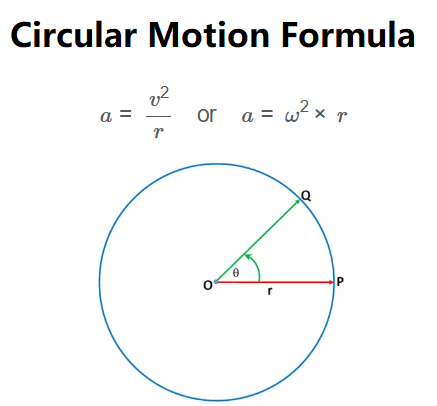1. What is a Circular Motion Calculator?
Definition: This calculator computes properties of circular motion, such as frequency, angular velocity, speed, and centripetal acceleration, given the time period and radius of the motion.
Purpose: It is used in physics to analyze objects moving in a circular path, such as satellites, amusement park rides, or particles in a centrifuge.
2. How Does the Calculator Work?
The calculator uses the following formulas:
Frequency:
\[
f = \frac{1}{T}
\]
Angular Velocity:
\[
\omega = \frac{2\pi}{T}
\]
Speed:
\[
v = \omega \times r
\]
Centripetal Acceleration:
\[
a = \frac{v^2}{r} \quad \text{or} \quad a = \omega^2 \times r
\]
Where:
- \( T \): Time period (sec, min, hr)
- \( f \): Frequency (Hz, RPM)
- \( \omega \): Angular velocity (rad/s)
- \( r \): Radius (mm, cm, m, in, ft, yd)
- \( v \): Speed (m/s, km/h, ft/s, mph, km/s, mi/s)
- \( a \): Centripetal acceleration (m/s², g)
Unit Conversions:
- Time Period (\( T \)): sec, min (1 min = 60 sec), hr (1 hr = 3600 sec)
- Frequency (\( f \)): Hz, RPM (1 Hz = 60 RPM)
- Angular Velocity (\( \omega \)): rad/s (radians per second)
- Radius (\( r \)): mm (1 mm = 0.001 m), cm (1 cm = 0.01 m), m, in (1 in = 0.0254 m), ft (1 ft = 0.3048 m), yd (1 yd = 0.9144 m)
- Speed (\( v \)): m/s, km/h (1 m/s = 3.6 km/h), ft/s (1 m/s = 3.28084 ft/s), mph (1 m/s = 2.23694 mph), km/s (1 m/s = 0.001 km/s), mi/s (1 m/s = 0.000621371 mi/s)
- Centripetal Acceleration (\( a \)): m/s², g (1 g = 9.80665 m/s²)
Steps:
- Enter the time period and radius, and select their units.
- Convert the time period to seconds and the radius to meters for calculations.
- Calculate the frequency, angular velocity, speed, and centripetal acceleration.
- Convert the frequency, speed, and acceleration to the selected units.
- Display the results, using scientific notation for values less than 0.001, otherwise with specified decimal places.
3. Importance of Circular Motion Calculation
Calculating circular motion properties is crucial for:
- Physics Education: Understanding the dynamics of circular motion.
- Engineering: Designing systems involving rotation, such as wheels, gears, or amusement park rides.
- Astronomy: Analyzing the motion of celestial bodies in orbits.
4. Using the Calculator
Examples:
- Example 1: For \( T = 23 \, \text{sec} \), \( r = 23 \, \text{m} \), frequency in Hz, speed in m/s, acceleration in m/s²:
- Frequency: \( f = \frac{1}{23} = 0.04348 \, \text{Hz} \)
- Angular Velocity: \( \omega = \frac{2\pi}{23} = 0.2732 \, \text{rad/s} \)
- Speed: \( v = 0.2732 \times 23 = 6.283 \, \text{m/s} \)
- Centripetal Acceleration: \( a = \frac{(6.283)^2}{23} = 1.7165 \, \text{m/s}^2 \)
- Example 2: For \( T = 2 \, \text{min} \), \( r = 50 \, \text{cm} \), frequency in RPM, speed in km/h, acceleration in g:
- Convert: \( T = 2 \times 60 = 120 \, \text{sec} \), \( r = 50 \times 0.01 = 0.5 \, \text{m} \)
- Frequency: \( f = \frac{1}{120} = 0.00833 \, \text{Hz} \), \( f = 0.00833 \times 60 = 0.50000 \, \text{RPM} \)
- Angular Velocity: \( \omega = \frac{2\pi}{120} = 0.05236 \, \text{rad/s} \)
- Speed: \( v = 0.05236 \times 0.5 = 0.02618 \, \text{m/s} \), \( v = 0.02618 \times 3.6 = 0.094 \, \text{km/h} \)
- Centripetal Acceleration: \( a = \frac{(0.02618)^2}{0.5} = 0.00137 \, \text{m/s}^2 \), \( a = \frac{0.00137}{9.80665} = 0.00014 \, \text{g} \)
- Example 3 (Small Values): For \( T = 0.1 \, \text{sec} \), \( r = 1 \, \text{mm} \), frequency in Hz, speed in m/s, acceleration in m/s²:
- Convert: \( r = 1 \times 0.001 = 0.001 \, \text{m} \)
- Frequency: \( f = \frac{1}{0.1} = 10.00000 \, \text{Hz} \)
- Angular Velocity: \( \omega = \frac{2\pi}{0.1} = 62.8319 \, \text{rad/s} \)
- Speed: \( v = 62.8319 \times 0.001 = 0.063 \, \text{m/s} \)
- Centripetal Acceleration: \( a = \frac{(0.063)^2}{0.001} = 3.949 \, \text{m/s}^2 \)
- Example 4: For \( T = 1 \, \text{hr} \), \( r = 1 \, \text{m} \), frequency in RPM, speed in m/s, acceleration in m/s²:
- Convert: \( T = 1 \times 3600 = 3600 \, \text{sec} \)
- Frequency: \( f = \frac{1}{3600} = 0.00028 \, \text{Hz} \), \( f = 0.00028 \times 60 = 0.01667 \, \text{RPM} \)
- Angular Velocity: \( \omega = \frac{2\pi}{3600} = 0.00175 \, \text{rad/s} \)
- Speed: \( v = 0.00175 \times 1 = 0.002 \, \text{m/s} \)
- Centripetal Acceleration: \( a = \frac{(0.002)^2}{1} = 0.000 \, \text{m/s}^2 \), display as \( 3.046 \times 10^{-6} \, \text{m/s}^2 \)
5. Frequently Asked Questions (FAQ)
Q: What is circular motion?
A: Circular motion is the movement of an object along a circular path, where the object maintains a constant distance (radius) from a central point.
Q: How is frequency related to time period?
A: Frequency (\(f\)) is the inverse of the time period (\(T\)): \( f = \frac{1}{T} \). It measures how many cycles occur per second (Hz) or per minute (RPM).
Q: What is centripetal acceleration?
A: Centripetal acceleration is the acceleration directed toward the center of the circular path, required to keep an object moving in a circle. It is calculated as \( a = \frac{v^2}{r} \) or \( a = \omega^2 \times r \).
Circular Motion Calculator© - All Rights Reserved 2025
 Home
Home
 Back
Back
